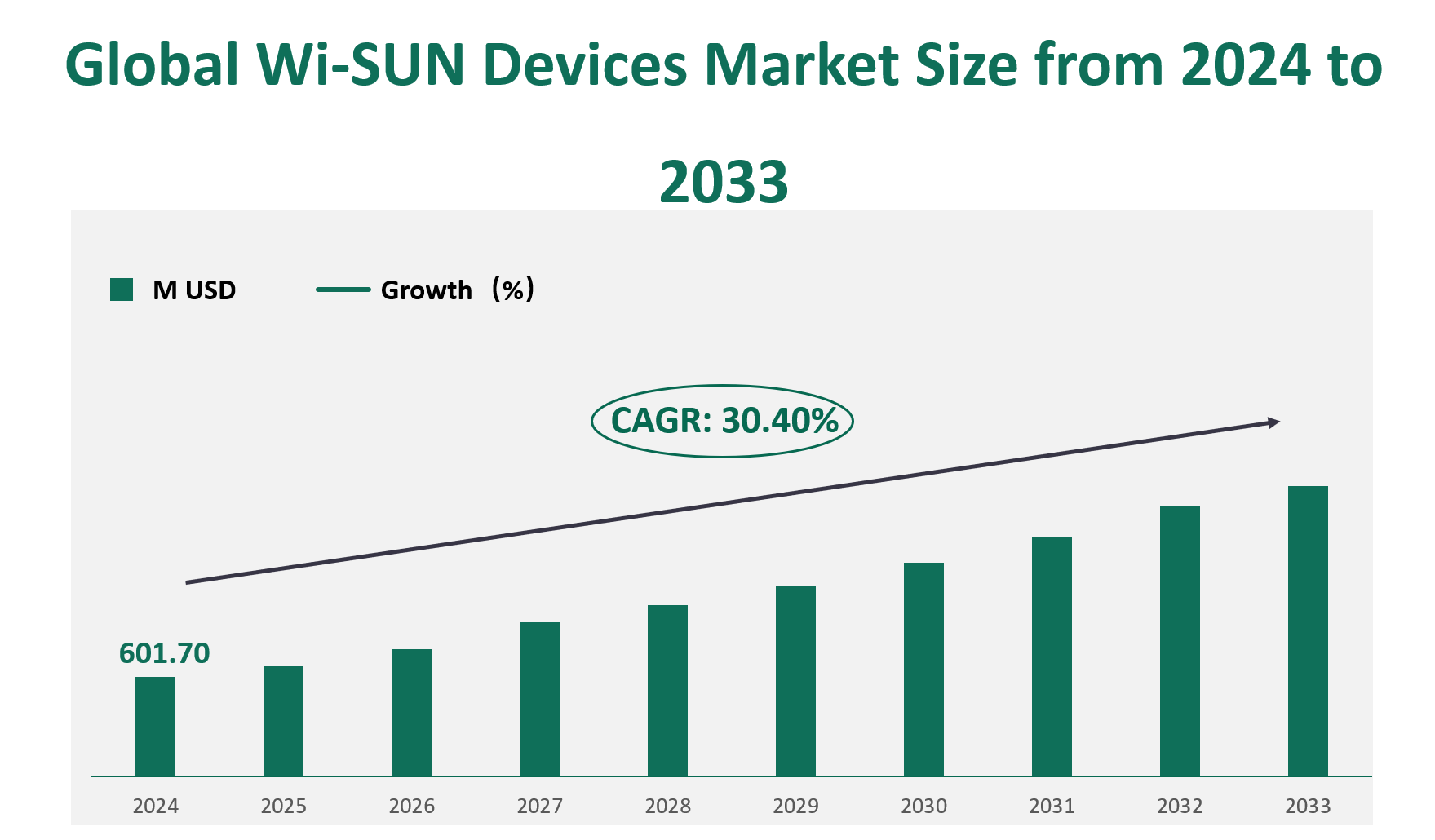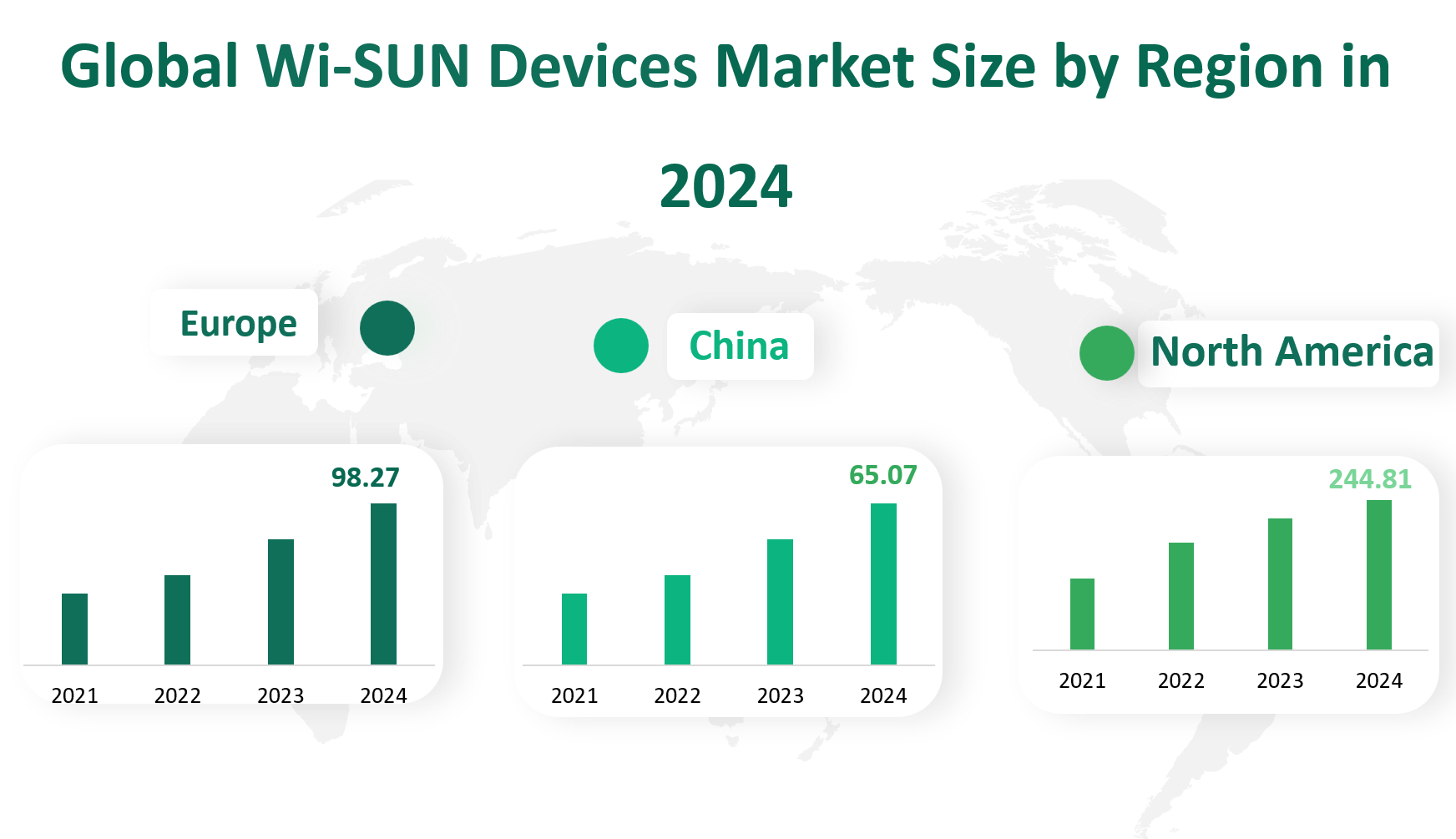1. Global Wi-SUN Devices Market Insight Analysis
The global Wi-SUN Devices market is projected to reach a value of $601.70 million USD in 2024, with a Compound Annual Growth Rate (CAGR) of 30.40% from 2024 to 2033.
Wi-SUN (Wireless Smart Ubiquitous Network) technology is based on open standards such as IEEE 802.15.4g, IEEE 802, and IETF IPv6. It enables seamless connectivity between smart grid devices and supports large-scale outdoor IoT network applications, including Field Area Networks (FAN) and Home Area Networks (HAN). Wi-SUN Devices, such as energy management (HEMS) controllers, play a crucial role in building wide-area, large-scale Internet of Things (IoT) systems. These devices are designed to enhance the efficiency and reliability of smart grid and smart city infrastructures by providing interoperable, multi-service, and secure wireless mesh networks. The technology is particularly advantageous due to its longer communication distance compared to Wi-Fi and faster data transmission speed compared to LoRa WAN and Sigfox.
Figure Global Wi-SUN Devices Market Size (M USD) and CAGR (2024-2033)

2. Driving and Limiting Factors of Wi-SUN Devices Market Growth
Increasing Demand from Downstream Markets: The expanding infrastructure of smart utilities and smart cities is driving the need for more interconnected devices. Wi-SUN technology is well-suited for these applications due to its long-range communication capabilities and high data transmission speeds.
Digital Transformation of Utilities: Utilities are increasingly adopting digital solutions to enhance grid management, improve efficiency, and reduce operational costs. Wi-SUN Devices support applications such as advanced metering infrastructure (AMI) and distribution automation (DA), which are critical for modernizing utility networks.
Smart City Initiatives: The global push towards smart city development is creating significant demand for Wi-SUN Devices. These devices enable the creation of Field Area Networks (FAN) for smart grids, street lighting, and other large-scale IoT applications, making cities more efficient and sustainable.
Photovoltaic Industry Growth: The photovoltaic sector is rapidly expanding, and Wi-SUN Devices offer flexibility in data rate and energy consumption, making them ideal for photovoltaic scenarios.
Complexity and High Cost of Terminal Equipment: The full mesh topology of Wi-SUN networks requires complex transmission, reception, and routing algorithms. This complexity increases the cost of terminal equipment, which can slow down adoption rates.
Intense Market Competition: The Wi-SUN Devices market is highly competitive, with many large enterprises vying for market share. New entrants face significant challenges in terms of technology, capital investment, and establishing a strong market presence.
Supply Chain Disruptions: Events such as the COVID-19 pandemic and geopolitical conflicts (e.g., the Russia-Ukraine war) have disrupted global supply chains, affecting the availability of raw materials and increasing production costs.
3. Technology Innovation and Corporate Mergers and Acquisitions in Wi-SUN Devices Market
Technological Innovation:
Advancements in Wireless Communication: Continuous improvements in wireless communication technologies are enhancing the performance and reliability of Wi-SUN Devices. These advancements include better signal strength, lower power consumption, and higher data transmission speeds.
Interoperability and Standardization: The Wi-SUN Alliance plays a crucial role in promoting interoperability among devices from different manufacturers. This standardization ensures that Wi-SUN Devices can seamlessly communicate with each other, fostering a more cohesive and scalable IoT ecosystem.
Integration with Emerging Technologies: Wi-SUN Devices are increasingly being integrated with other emerging technologies such as 5G, artificial intelligence (AI), and machine learning (ML). This integration enables more intelligent and automated IoT applications, further expanding the potential use cases for Wi-SUN Devices.
Corporate Mergers and Acquisitions:
Cisco Completes Acquisition of Sedona Systems: In June 2021, Cisco acquired Sedona Systems, a leading provider of network controllers. This acquisition aims to enhance Cisco’s capabilities in routed optical networking and improve its network automation portfolio.
Murata Acquires Eta Wireless: In September 2021, Murata Manufacturing Co., Ltd. acquired Eta Wireless Inc., a developer of digital envelope tracking technology. This acquisition strengthens Murata’s position in communication and electronic components by incorporating Eta Wireless’s power management technology.
Landis+Gyr Receives Wi-SUN Certification: In July 2022, Landis+Gyr announced that its next-generation grid sensing smart meter, Revelo®, passed the Wi-SUN FAN 1.0 certification. This certification ensures that Revelo can interoperate with any Wi-SUN-enabled network, enhancing its market competitiveness.
4. Global Wi-SUN Devices Market Size by Type
Wi-SUN Devices are categorized into several types, each serving specific functions within the IoT and smart grid ecosystems. The main product types include Bridges and Gateways, RF Modules/Transceivers, Adapters and HEMS Controllers, Routers, and Others.
Bridges and Gateways: These are backbone devices of a network, connecting different LANs and translating protocols between networks. In 2024, the market value for Bridges and Gateways is projected to reach $92.64 million. They play a crucial role in integrating various devices and systems, making them essential for smart city and utility applications.
RF Modules/Transceivers: These modules are responsible for transmitting and receiving radio signals, enabling wireless communication between devices. With a market value of $171.96 million in 2024, RF Modules/Transceivers are a significant part of the Wi-SUN Devices market. Their ability to facilitate data transmission over long distances makes them ideal for Field Area Networks (FAN) and other large-scale IoT applications.
Adapters and HEMS Controllers: These devices act as interfaces between different systems and are used for energy management and home automation. In 2024, the market value for Adapters and HEMS Controllers is expected to be $210.96 million. They are critical for enabling smart home solutions and optimizing energy consumption in residential settings.
Routers: Routers connect multiple networks and facilitate data routing. The market value for Routers in 2024 is projected to be $85.86 million. They are essential for creating robust and scalable IoT networks, particularly in smart grid applications.
Table Global Wi-SUN Devices Market Size by Type in 2024
Market Size (M USD) 2024 | |
Bridges and Gateways | 92.64 |
RF Modules/Transceivers | 171.96 |
Adapters and HEMS Controllers | 210.96 |
Routers | 85.86 |
Others | 40.26 |
5. Global Wi-SUN Devices Market Size by Application
The applications of Wi-SUN Devices span various sectors, each with its own market dynamics and growth potential. The main applications include Field Area Network (FAN), Home Area Network (HAN), and Others.
Field Area Network (FAN): FAN is a robust, low-power wireless mesh network used for IoT applications, particularly in smart grids and utility management. In 2024, the market value for FAN is projected to be $404.80 million. FANs enable the collection and analysis of energy distribution data, making them essential for optimizing utility operations and enhancing grid reliability.
Home Area Network (HAN): HAN refers to the network within a user’s home, connecting smart devices such as laptops, smartphones, and home appliances. The market value for HAN in 2024 is expected to be $182.39 million. HANs facilitate communication and resource sharing among smart devices, enhancing home automation and energy management.
Table Global Wi-SUN Devices Market Size by Application in 2024
Application | Market Size (M USD) 2024 |
Field Area Network (FAN) | 404.80 |
Home Area Network (HAN) | 182.39 |
Others | 14.51 |
6. Global Wi-SUN Devices Market by Top Regions
North America is projected to have a market value of $244.81 million in 2024. The region’s strong economic foundation and technological prowess make it a leading market for Wi-SUN Devices. The United States and Canada are at the forefront of smart grid and IoT implementations, driving the demand for advanced Wi-SUN solutions.
Europe’s market value is expected to reach $98.27 million in 2024. The region’s commitment to sustainable energy and digital infrastructure has spurred the adoption of Wi-SUN Devices. European countries, particularly those in the EU, are investing heavily in smart grid technologies to enhance energy efficiency and reduce carbon emissions. The push for smart cities and digitalization across the continent is a key driver for the growth of the Wi-SUN Devices market.
China’s market value is projected to be $65.07 million in 2024. As the world’s second-largest economy, China is rapidly advancing its smart grid and IoT infrastructure. The government’s support for new infrastructure projects, including 5G and smart city development, is driving the demand for Wi-SUN Devices.
Japan’s market value is expected to be $162.25 million in 2024. Japan’s strong industrial base and focus on technological innovation make it a significant player in the Wi-SUN Devices market.
Middle East and Africa market value is projected to be $13.64 million in 2024. While the region’s market value is relatively smaller compared to other major regions, it is experiencing rapid growth.
Figure Global Wi-SUN Devices Market Size by Region in 2024

7. Global Wi-SUN Devices Market Analysis by Major Players
7.1 Cisco Systems Inc.
Company Introduction and Business Overview: Cisco Systems Inc., established in 1984, is a global leader in networking and IT solutions. The company designs, manufactures, and sells a wide range of networking products and services, including routers, switches, and wireless devices.
Products Offered: Cisco offers a variety of Wi-SUN Devices, including the Catalyst IR8100 Heavy Duty Series Router, which is designed for industrial applications and provides robust connectivity in harsh environments.
Sales Revenue in 2022: $44.93 million.
7.2 Itron Inc.
Company Introduction and Business Overview: Itron Inc., established in 1977, is a leading provider of solutions for collecting, communicating, and analyzing electricity, natural gas, and water usage data. The company serves the utility industry with advanced metering infrastructure and IoT solutions.
Products Offered: Itron offers products such as the WSA0174 – Itron Bridge 5-WS FAN, which enables the integration of control and monitoring devices into a secure Wi-SUN Field Area Network.
Sales Revenue in 2022: $36.75 million.
7.3 Landis+ Gyr
Company Introduction and Business Overview: Landis+ Gyr, established in 1896, is a global leader in energy management solutions. The company provides advanced metering infrastructure and smart grid technologies to utilities worldwide.
Products Offered: Landis+ Gyr offers products such as the N2200/N2250 Network Bridge, which connects a diverse ecosystem of devices and provides distributed intelligence for smart grid applications.
Sales Revenue in 2022: $32.47 million.

